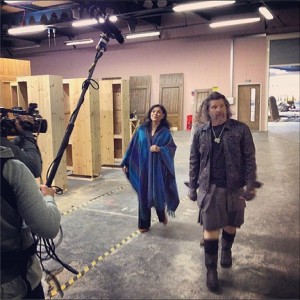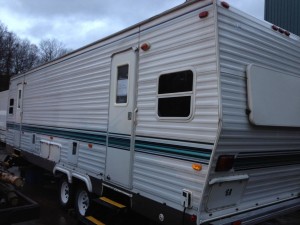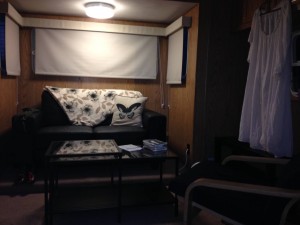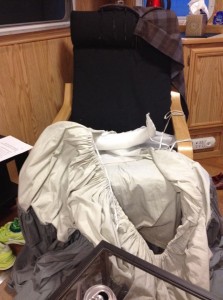My Brief Career As A TV Actor (Part I)
In early February, 2014, Diana travelled to Scotland to film a cameo for the Outlander TV series:
You know, I’m not at all surprised that actors have occasional trouble dealing with Real Life. Not that they can’t separate the reality of their characters (and believe me, it is a reality) from that of their own personae—but if you’re a film actor, Real Life doesn’t exist for you on the job.
 After a read-through of Block 3 and a production meeting on Monday, then a huge and fascinating tour of “Outlander-world” (and I’ll tell you about all these in some detail, but later; I had four hours sleep last night, a call for 5:30 AM this morning (Thursday, that is) which meant I got up at 4:30, and another Really Full Day) on Tuesday—followed by hours of press interviews—I embarked on My Brief Career as a TV Actor Wednesday morning (February 5).
After a read-through of Block 3 and a production meeting on Monday, then a huge and fascinating tour of “Outlander-world” (and I’ll tell you about all these in some detail, but later; I had four hours sleep last night, a call for 5:30 AM this morning (Thursday, that is) which meant I got up at 4:30, and another Really Full Day) on Tuesday—followed by hours of press interviews—I embarked on My Brief Career as a TV Actor Wednesday morning (February 5).
(Image at right: Diana and Executive Producer Ron Moore.)
“Call” means the hour at which a car comes to your residence to pick you up and transport you to work. There are five “unit drivers” who work for the Outlander production, all vivid personalities in their own right. <g> (You can follow some of them on Twitter, with handles such as @daviehollywood, and give them your opinion of their suggested project of having a “Drivers of Outlander” calendar. Davie asked me what I thought of the notion, to which I replied, “I dunno… Full Monty or G-strings?” Didn’t get an answer to that one yet.)
The production office gives you (any actor, that is) a call sheet for the next day, when you leave at night— this tells you when to be picked up, when to report to hair/makeup, and the theoretical time at which you’ll be on set, along with other arcane information as to whether they think you’ll be filming only that day or for several days, and if so, which ones (this all being subject to change).
So Wednesday, my husband (riding along as company photojournalist and documentarian) and I were picked up at 6:55 AM, as per the call sheet, and driven round a few corners to pick up Caitriona Balfe and her younger sister Lorraine, who’s working in Costume on the Outlander production. Both lovely young women, and as friendly and funny as one can reasonably be expected to be at that hour of the morning.
 We were all decanted at the back of the lot, where the trailers are. Now, the “artists” (the regular performers, as opposed to the Supporting Actors, or extras) each have trailer space— in this case, most have half of a large two-person trailer. You can see mine <g> in the photo at right— the trailers have the character names on the doors, and are quite cozy inside. (There’s a tiny bathroom in each trailer-half, as well, with a pump toilet, and the living room (shown in the image below) has a pop-out where the sofa lives. Otherwise, it’s sparsely but comfortably furnished with a comfortable chair, a coffee-table, a tiny refrigerator, and a tray with such amenities as Kleenex, an electric carafe, and Tetley’s tea-bags.)
We were all decanted at the back of the lot, where the trailers are. Now, the “artists” (the regular performers, as opposed to the Supporting Actors, or extras) each have trailer space— in this case, most have half of a large two-person trailer. You can see mine <g> in the photo at right— the trailers have the character names on the doors, and are quite cozy inside. (There’s a tiny bathroom in each trailer-half, as well, with a pump toilet, and the living room (shown in the image below) has a pop-out where the sofa lives. Otherwise, it’s sparsely but comfortably furnished with a comfortable chair, a coffee-table, a tiny refrigerator, and a tray with such amenities as Kleenex, an electric carafe, and Tetley’s tea-bags.)
 Someone (there are people all over the lot whose job is to keep track of other people— particularly the artists. When you’re working, someone knows where you are at every given minute, and you can be found instantly. They hand you off to one another like—exactly like—a parcel. (Though a cherished and respected parcel, to be sure.)
Someone (there are people all over the lot whose job is to keep track of other people— particularly the artists. When you’re working, someone knows where you are at every given minute, and you can be found instantly. They hand you off to one another like—exactly like—a parcel. (Though a cherished and respected parcel, to be sure.)
All the trailers had very narrow, very steep steps up to the doors— ungodly treacherous to negotiate while wearing an 18th century costume, I tell you, but I luckily managed not to fall off and break my neck (I did break the costume a couple of times, but that’s another story), and whenever you’re –in- your trailer, people come and knock at the door at frequent intervals— bearing food (breakfast and lunch are not only provided, but brought out to you), costumes, or prepared to take you wherever you’re meant to be next.
In this instance, someone popped up and instructed me to take off my shirt, don the pink, fuzzy, hooded bathrobe on the couch, and come with them. I did, and they took me to Hair and Makeup, where Annie (the lovely head of the department, with a deep interest— and extensive research— on the hair styles of the 18th century) oversees things. Julie made me up— very basic makeup, as your average 18th century respectable woman wouldn’t be wearing any; mine essentially just lightened my skin tone, evened it out, and provided a minimally reflective surface for the camera (this augmented by powder, applied roughly every five minutes when the cameras weren’t actually running— more on that later, too)— and then fitted my wig. This was… um… Amazing, is probably the only reasonable word. I’m not allowed to show you my costume (the Starz people want to keep some secrets), but it was… er… well, I saw much bigger, fancier ones, let’s put it that way. And it was roughly the color of my own hair.
Prep for wearing a wig meant they plaited my hair into four tiny braids and criss-crossed these back and forth over my head, anchoring them with flat metal hair-clips. This provided a base to which the wig could be attached, with zillions of hoop-shaped hair pins in different calibers.
The wig itself is human hair, carefully dressed and styled, mounted on a “lace” sort of cap. By “lace,” they mean the very fine mesh to which the hair is attached. This cap fits over your own hair, and the extensions of the lace fit across the top of your forehead and down in front of your ears. Once they’d got the wig fixed securely, they trimmed the lace to a minimum, and then pasted it to my face with some fixative that looked more or less like pine-pitch, but probably wasn’t. Once pasted, the lace essentially becomes invisible; you can’t see it even when standing right next to a person wearing it— unless the fixative has dried unevenly or had not quite enough put on, in which case the lace raises unevenly off the skin, and people are seen to put a hand to their temple and exclaim, “My lace is dimpling!”— whereupon a Makeup person materializes magically beside them, alcohol-laden brush at the ready (the alcohol dissolves the fixative, allowing the lace to be lifted clear of the skin, smoothed and refixed).
Someone was waiting for me as I stepped out of the Hair-Makeup trailer, and after asking me what I wanted for breakfast (they have all the standard things; I chose bacon, eggs, and toast), took me back to my trailer to startle my husband.
Breakfast showed up promptly— along with the Diet Coke I’d requested; most people on set drink tea or coffee or water all day, but as Ron D. Moore runs on Diet Coke, too, there was always a supply to hand— followed in short order by two ladies from Costume, bearing the pieces of my outfit.
 I can’t show it to you— beyond the quite generic petticoat on the right (it’s made of canvas and muslin)— but it consisted of a knee-length muslin shift, knee-high green stockings (thick ones), reddish-brown shoes with satin ribbon ties, a set of stays (a corset) that went over the shift, the aforementioned petticoat (which they held for me and I sort of dived in, so they could pull it down over the shift and stays, and a bum-roll, which is just what it sounds like (didn’t think to take a picture, but you can find one easily with Google)— wide hips were apparently sexy in the 18th century.
I can’t show it to you— beyond the quite generic petticoat on the right (it’s made of canvas and muslin)— but it consisted of a knee-length muslin shift, knee-high green stockings (thick ones), reddish-brown shoes with satin ribbon ties, a set of stays (a corset) that went over the shift, the aforementioned petticoat (which they held for me and I sort of dived in, so they could pull it down over the shift and stays, and a bum-roll, which is just what it sounds like (didn’t think to take a picture, but you can find one easily with Google)— wide hips were apparently sexy in the 18th century.
Stays. These lace up the back, and it takes considerable effort to get them adequately tightened. As in— if it’s done properly, you can’t breathe, though you do acclimate to this. You really can’t bend over, so my husband had to keep retying the ribbons on my shoes, until he gave up and double-knotted them. Does give you the desired wasp-waisted look, though, I’ll say that.
Anyway, once all these layers had been applied, my dressers put on the piece-de-resistance, an absolutely gorgeous dress designed especially for me by Terry Moore, head of the Costume Department (and more about that when I reprise the Tour in a later post). Crushed velvet, gold lace, MacKenzie tartan stomacher and sacque-back… and I can’t say more than that, but it was gorgeous. Once I was in it, they opened the door and invited in Crawford, the only (apparently) male employee of the Costume Department (though it employs 75 people on staff, and I didn’t seen anywhere near all of them, so can’t swear to this), as Muscle was required to lace up the dress itself over the stays.
It looked great, but I tell you— once tightened and dressed in all the layers, you really can’t do much beyond walk and wave your arms in a circumscribed sort of way. Going to the bathroom is possible (just), but no simple undertaking. You can sit down, but you don’t lean back— not out of fear of rumpling your clothes, but because you can’t. You have great posture, involuntary though it is.
I was then left to wheeze gently and talk to my husband for a bit, having been assured that someone would come get me— and sure enough, someone did come to escort me to the sound stage where filming was to take place that day. (There are two sound stages; the one I was on was the one where the Great Hall is built— and one impressive set it is, too.)

(The last photo here is what’s on the outside of the set.)
Now, I do need to sleep a little more tonight (I slept for a few hours because I had to, but then got up to do a modicum of writing— mostly this post), because while tomorrow’s call isn’t as ungodly early as Thursday’s, I am still working tomorrow.
If I have time after tomorrow’s work, though, I’ll tell you all about the Gathering, the Great Hall, and how filming really works. Stay tuned!
-Diana
Click here for Part II of My Brief Career As A TV Actor.
This story first posted by Diana on February 7, 2014, on her FaceBook page.
This page was last updated by Loretta on Monday, June 23, 2014 at 6:11 a.m. (PDT)